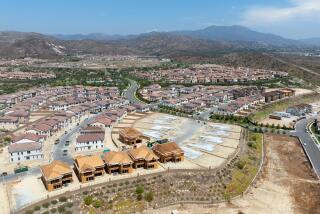Historical Peeks Are Part of Visit
- Share via
SANTIAGO CANYON — More than 1 million people visit Irvine Regional Park every year, but those who come only to picnic, walk or play catch at the 477-acre facility are missing part of its history.
“We want people to come here first,” Park Ranger Sam Edwards says, pointing to the Interpretive Center, also known as the Exhibit Pavilion, which houses a small but informative museum. There, the plant life, wildlife, geology and the origins of the park, which was established 94 years ago as a gift to the county from rancher James Irvine, are explained.
“We can show them what to look for and give them an idea of who has been here before them,” he says. “We can take a group of youngsters, sit them down in a picnic in the oaks and point out that families of Indians probably ate in the same spot, hundreds of years before them.”
An equestrian trail surrounds the 6-mile circumference of the facility, and horses may be rented from a concessionaire. Horse owners may board them at stables in a northwestern sector of the park, near the Orange County Zoo, also within the park.
Pony rides are available for small children, and paddle boats for use on the park’s lake can be rented. There are picnic tables throughout the facility, along with softball fields, volleyball courts and horseshoe pits.
The park, which is the state’s largest regional park, and the surrounding area were part of the Yorba land grant in the 19th Century. It was sold in 1860 to a rancher who used it for cattle grazing. Five years later, several Northern California ranchers bought it for sheep grazing.
It was during that time, as Santa Ana, Orange and Anaheim grew, that the area became known as the Picnic Grounds and visitors started arriving on foot, horseback and by carriage.
James Irvine bought out his partners in 1876 and the area became part of Irvine Ranch, which then totaled 95,000 acres. In 1897, James Irvine Jr. gave 160 acres to the county, asking that it be kept as natural as possible. It was called Orange County Park at that time but was renamed to honor Irvine in the late 1920s.
After Irvine donated the initial 160 acres to the county, development was surprisingly rapid, considering how isolated the area must have been a century ago. A pavilion for band concerts and dances was built in 1900, the lake was excavated and filled from natural springs in 1913, and the boathouse followed a year later.
In the 1920s, a cannon from the Civil War was placed at the side of the lake, next to a memorial to four men who died on the battleship Maine preceding the Spanish-American War.
The building that now holds the Interpretive Center was constructed in 1930, as was a food concession building, also still standing. Around that time, the area became a popular location for motion picture filming. Edward G. Robinson, Mickey Rooney, Dick Powell and Irene Dunne were among the stars who made films there, and it was the site for several of the “Lassie” films.
For three years during World War II, it became an Army training camp.
In 1983, just after a $5 million renovation program began, Irvine Regional Park was listed on the National Register of Historic Places.
Edwards, the ranger-naturalist who works out of the Interpretive Center, constantly changes and upgrades several nature programs. From December through March, he has scheduled a series of lectures--on recycling, local history and wildlife--many of which are free.
The small zoo concentrates on animals normally found in the area. These include goats, raccoons, ferrets, opossums, sheep, coyotes, wolves, burros and mule deer, and such birds as owls and various species of falcons.
Edwards says the non-zoo animals seem to have a sense of what day of the week it is. “On weekends, when the crowds are here, you won’t see nearly as much wildlife,” he said. “But during the week, when it’s quiet, you see all the gray foxes, ground squirrels and skunks, toward nighttime, along with acorn woodpeckers and other bird life.”
The lake has a good assortment of mallards, wood ducks, coots, cormorants and an occasional pelican and heron.
The southern boundary of the park is the site of the William Harding Nature Area, which is worthy of a visit on its own. Harding was a member of the Orange County Birding Club and was a longtime supporter of wildlife sanctuaries and nature facilities. The nature trail, less than a quarter-mile in length, combines signposts with such native California plants as elderberry, flannel bush, wild rose, manzanita, desert willow and, for viewing only, poison oak.
Rabbits, ground squirrels, wood rats and scrub jays are in greater abundance here than in the more heavily traveled parts of the park. Red-tailed hawks circle overhead, always looking for a mouse or other small animal that might be less attentive than it should have been.
The park is administered by the Orange County Environmental Management Agency’s Department of Harbors, Beaches and Parks. A total of 26 full-time rangers, attendants and assistants operate the park.
The park is open every day of the year. Between Nov. 1 and March 31, the park is open from 7 a.m. to 6 p.m., and between April 1 and Oct. 31, it is open from 7 a.m. to 9 p.m. The Interpretive Center is open only on Saturdays and Sundays from 10 a.m. to 4 p.m.
Entrance is $2 for cars and $10 for buses. An annual day-use pass is available for $30 and for $7.50 for those 60 or older, as well as the handicapped. No overnight camping is allowed. The park’s telephone number is (714) 633-8074.
More to Read
Sign up for The Wild
We’ll help you find the best places to hike, bike and run, as well as the perfect silent spots for meditation and yoga.
You may occasionally receive promotional content from the Los Angeles Times.






